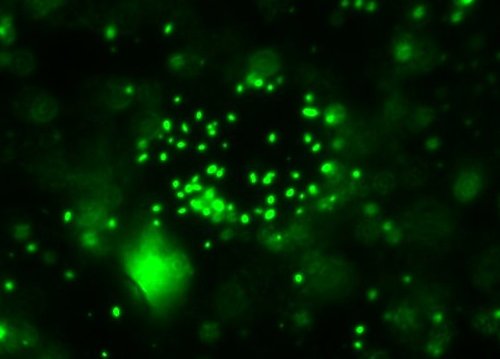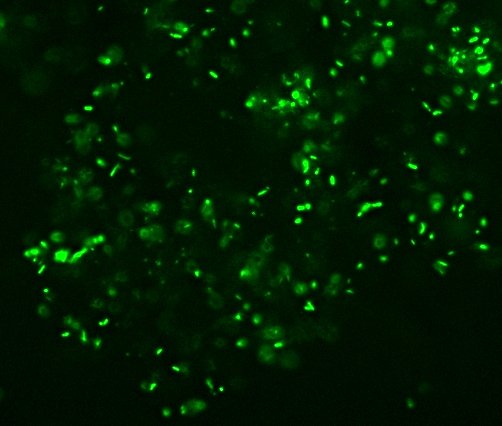I couldn’t resist doing a bit of research to track down what “schizomycete” meant. I can’t help it, it’s fun, and in this case also was both informative and amusing. Don’t tell the Psych department, though – I think the MMPI probably formally classifies this kind of thing as a perversion…
In any case, here’s what I’ve come up with.
First, a simple Google search turned up some online “medical dictionary” sites. Where they had a definition of the term, they just said it was “a class of bacteria” (or something similarly vague). However, neither the NCBI Taxonomy Browser nor the RDP Heirarchy Browser seemed to have any kind of category called “schizomycete” (or “Schizomycetales” or similar variant). Obviously, the term is no longer in use.
Although my academic interests are specifically not medical in nature, I do casually collect old medical (and scientific) books. So, I dug out my handy 1953 “Stedman’s Shorter Medical Dictionary (“Revised and Enlarged”)” and looked up the term. Here’s what it said:
“A class of vegetable organisms which reproduce by fission; fission-fungi or bacteria.”
“Fission-fungi“???Okay, I can excuse such an obviously archaic term in a dictionary from 1953 – at that point, Watson, Crick, and Franklin hadn’t even puzzled out the structure of DNA yet (in fact there aren’t even entries for DNA or Deoxyribonucleic acid in this edition). What’s funny, though, is that I stopped in on the campus library and looked at the current edition of Stedman’s Medical Dictionary and the famous Physician’s Desk Reference. The current (2006) Stedman’s still has an entry for “Schizomycete”, as well as an entry for “schizomycetic”. “Schizomyces” now says:
“Member of class schizomycetes; a bacterium”
Even funnier, “Schizomycetic” says:
“Relating to or caused by fission-fungi (bacteria)”
Okay, the fact that they’re happily referencing a bacterial “class” that was rendered obsolete and nonexistent decades ago is funny enough…but they STILL refer to “fission-fungi”? Unless I’m mistaken, that would be like looking up a current “Dictionary of Chemistry and Physics” and seeing an entry that describes some optical phenomenon in such a way as to make reference to “the Aether”.
I was perversely even more amused to see that, as I recall, the famous “Physician’s Desk Reference” happily parroted the definition word-for-word.
Judging by the occurrence of the term in Pubmed, the term “Schizomycete” disappeared sometime in the mid-1980’s, and even then was used almost exclusively in Italian journals (presumably it was just slower to drop out of the language than in English). I did find, however, a series of articles on bacterial taxonomy which started in 1916, and included an entire article from 1917 on “Schizomycetes”[1]. Being 90 years old, this is a mature public-domain work so you can make, print, and share all the copies you want (Even in the U.S., believe it or not). Pubmed has a copy here if you’re interested.
In the end, though, here’s the summary:
Even when it was in common use, it seems like “Schizomycete” was an unreliable term. It seems to have been in use during a time when there was a lot of argument over how to categorize microbes. The 1917 article has a whole section discussing the historical meanings of the term and where various researchers drew the lines of what was a “schizomycete” or not. In general, it seems to have usually meant any relatively “ordinary” bacteria that didn’t produce chlorophyll (that is, wasn’t some kind of “algae“)
In honor of the completion of this batch of grueling and difficult research, I hereby declare by the power vested in me that henceforth “Schizomycetic” shall be defined as “pertaining to any relatively unremarkable-looking prokaryotic organism” and that all microbiology-related professionals should be compelled to use the term regularly. I further decree that the terms “aerobic” and “anaerobic” shall be replaced by “dephlogisticated” and “phlogisticated”, respectively.
Incidentally – Hello, “Tangled Bank” readers! Comments, suggestions, and corrections on any of my postings (or this blog in general, for that matter) are welcome and encouraged, in case that isn’t clear.
[1] – Buchanan RE, “Studies in the Nomenclature and Classification of the Bacteria: II. The Primary Subdivisions of the Schizomycetes.” Journal of Bacteriology. 1917 Mar; 2(2):155-64



